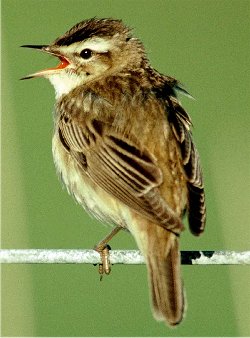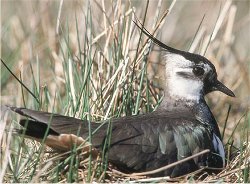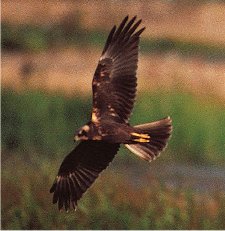|
GreenPlaces
|
|
Wildlife and conservation news from around the U.K. |
|
Menu
|
 |
|
||||||
|
The songbirds that inhabit the reed-beds of Minsmere, the third largest habitat of this type in Britain, have bred well this year, too. The Grasshopper Warbler (Locustella naevia) count has increased from only four singing males last year, to 17 singing males this year and the population of Reed Buntings (Emberiza schoeniclus), which are redlisted as birds of greatest conservation concern, has almost doubled from 31 males in 2003, to 60 males this year. Sedge Warbler (Acrocephalus shoenobaenus) numbers have increased from 81 to 181 this year. The reed-beds are also home to a healthy population of Otters (Lutra lutra) and Water Voles (Arvicola terrestris). Water Shrews (Neomys fodiens) also occur here and the rare Norfolk Hawker dragonfly (Aeshna isosceles), previously confined to the Broads, was recorded for the third successive year.
Minsmere's wetland warden, Ian Hawkins, said, "Minsmere's reedbeds are well known for their breeding bitterns, but these results show that they are a haven for wildlife. The sight of so many young Marsh Harriers over the reserve was fantastic and it is especially pleasing to see that so many threatened species are thriving here. This is a great reward for the hard work of all our staff."
Little Terns (Sterna albifrons), one of Britain's rarest seabirds, have returned to Minsmere after being absent since 2001. 15 pairs nested here and raised about 20 young between them. Common Terns (Sterna hirundo) have also done well. |
|
|
Links |
|
|
RSBP Minsmere Nature Reserve |
|
|
RSPB Bittern Species Guide |
|
|
BTO British Trust for Ornithology Grasshopper Warbler Information |
|
|
Images |
|
|
Sedge Warbler, Minsmere Nature Reserve, Chris Gomersall, RSPB Images www.rspb-images.com |
|
|
Lapwing, Minsmere Nature Reserve, RSPB Images www.rspb-images.com |
|
|
Marsh Harrier, Minsmere Nature Reserve, RSPB Images www.rspb-images.com |
|

 For the second year in a row, Marsh Harriers (Circus aeruginosus) at the reserve produced a record number of young, with 30 young birds fledging successfully from 10 nests. This species has recovered from just 1 pair in the UK, at Minsmere, in 1972.
For the second year in a row, Marsh Harriers (Circus aeruginosus) at the reserve produced a record number of young, with 30 young birds fledging successfully from 10 nests. This species has recovered from just 1 pair in the UK, at Minsmere, in 1972. There are now nine calling male Bitterns (Botuarus stellaris) living on the reserve which is good news for Britain's rarest breeding bird species. The secretive Water Rail (Rallus aquaticus) has increased from 61 to 81 pairs and there are now twenty pairs of Cetti's Warbler (Cettia cetti), which is a recent returning resident to Minsmere.
There are now nine calling male Bitterns (Botuarus stellaris) living on the reserve which is good news for Britain's rarest breeding bird species. The secretive Water Rail (Rallus aquaticus) has increased from 61 to 81 pairs and there are now twenty pairs of Cetti's Warbler (Cettia cetti), which is a recent returning resident to Minsmere. Waders at the reserve have done well this year, while most populations in Britain have declined. The damp meadows and marshes they need for breeding in the UK have disappeared due to changes in land management, but good management of the land at Minsmere has improved the suitability of the grazing marshes for waders, resulting in increased breeding success. Redshanks (Tringa tetanus) have increased from nine to eleven pairs, Oystercatchers (Haematopus ostralegus) from three to five pairs and Snipe (Gallinago gallinago) increased from only one pair in 2003 to five this year. Lapwings (Vanellus vanellus), which have undergone a marked decline in the UK over the past few years, have done very well increasing from 12 to 23 pairs since 2003. They have produced many young and 2004 has proved to be their most successful year at Minsmere for over 10 years. There are now only 250 pairs of Lapwings in the whole of Suffolk, when once they were a common sight.
Waders at the reserve have done well this year, while most populations in Britain have declined. The damp meadows and marshes they need for breeding in the UK have disappeared due to changes in land management, but good management of the land at Minsmere has improved the suitability of the grazing marshes for waders, resulting in increased breeding success. Redshanks (Tringa tetanus) have increased from nine to eleven pairs, Oystercatchers (Haematopus ostralegus) from three to five pairs and Snipe (Gallinago gallinago) increased from only one pair in 2003 to five this year. Lapwings (Vanellus vanellus), which have undergone a marked decline in the UK over the past few years, have done very well increasing from 12 to 23 pairs since 2003. They have produced many young and 2004 has proved to be their most successful year at Minsmere for over 10 years. There are now only 250 pairs of Lapwings in the whole of Suffolk, when once they were a common sight.